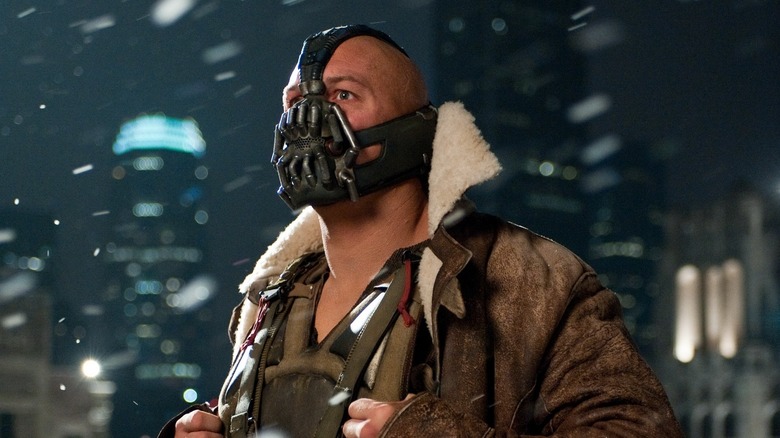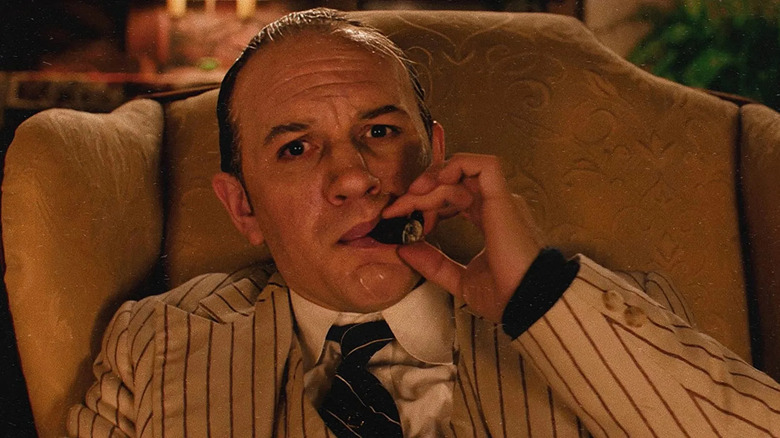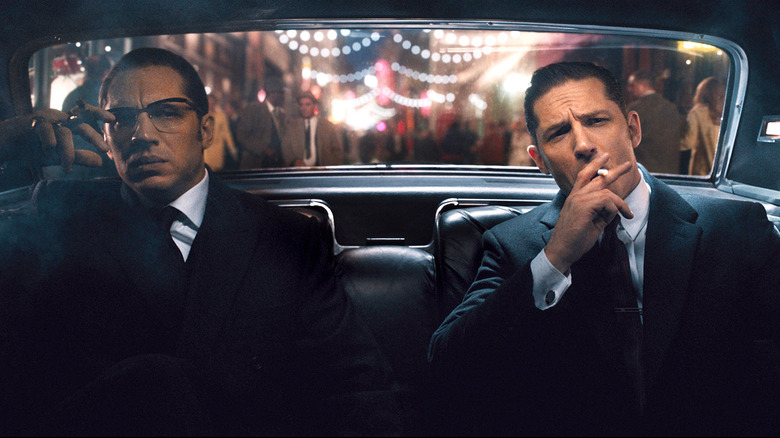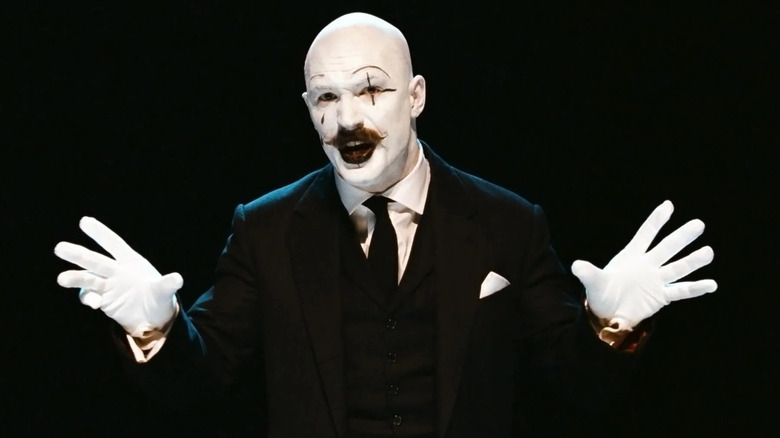Tom Hardy Tries To Combine Two Very Different Types Of Acting
It might be redundant to say that Tom Hardy is an actor who has worn many masks — that's kind of his job, right? But there is something to be said of the extent to which he morphs himself into the characters he plays. After all, Hardy has shown he's in that special category of actors who are willing to sacrifice their bodies at the altar of any role they take. Be it to adopt the chiseled physique of a mixed martial arts fighter in "Warrior" or to create the illusion of a certain beefed-up supervillain in "The Dark Knight Rises." Every role he appears in is distinct, because Hardy never prepares for a part the same way twice.
I once heard someone complain that Liam Neeson was once one of their favorite actors — until they realized he was playing the same version of himself from "Taken" in pretty much every movie he'd released afterwards. Which is less a criticism and more an observation on acting approaches. Some actors show up to a role and just play themselves, maybe they put on a costume, but everything from their mannerisms to their accent remains their own. Hardy on the other hand fully envelops himself into his characters, emerging almost unrecognizable — or unintelligible, as some who haven't discovered subtitles sometimes complain.
But whatever your opinions on Hardy's vocal switch-ups, it's safe to say they're integral to his approach to acting. Part of the mask he tailors for each role and the reason each feels so drastically different from the other.
Hardy's two approaches to acting
As much as Hardy immerses himself into his roles, he never goes full-on method-actor. Instead, he told A.V. Club, he tries to keep himself firmly in between two different approaches. The first he refers to as "camouflage," where you "put on a hat, a rubber nose, a cloak, put false teeth in, and I change my accent and walk with a limp." Hardy pointed out the approach has been around for a while, from Greek tragedies and Vaudeville to Pixar Studios, where actors work with motion capture and must imagine themselves as animated characters.
The other approach he calls the "hustle," which encompasses the drive one needs as an actor to take on different roles and go the extra mile in playing them. Hardy's own whirlwind rise from "Black Hawk Down" to one of the biggest names in film and television is evidence enough of his commitment. But for the most part, the actor said he's tried to have a "foot in both camps" so he can rely on the strengths of either to sustain him. Case in point: for his role as aging gangster Al Capone, Hardy relied on his Colin Farrell/Penguin-level camouflage to sink into the character.
"Now, you can do that in your own accent and have a healthy career, just changing different hats, having a nice haircut, a nice suntan, a six-pack, and a set of great teeth," he said. "You can go a long way with that style of acting." But that's evidently not the path Hardy takes, since the one thing he never does is use his own voice for a role: "You can only have one shot at doing that, and then you're done unless you make a career out of being you."
Pigeon-holed as the funny voice guy
Hardy points out the biggest irony of it all is that he's become pigeonholed as the "bloke who always does the silly voice." But that's a rather poor simplification of what the actor is trying to accomplish with his different accents. Hardy told A.V. Club, "The constant is, though, that I just want to make the effort to try and transform as much as possible from one character to another, so that people can immerse themselves into the story and not in my performance. That's my job, isn't it?"
His dual roles as the Kray twins in "Legend" are stellar examples of the lengths the actor can go to in order to create the convincing illusion that he's two different people. But a lot of that is rooted in his vocal talents as well, the origins of which date back to his time in drama school (where he was eventually kicked out). It was there Hardy learned that prior to stepping onto any stage, he needed to first have a minimum of seven different characteristics for that role ready to embody.
"In order to transform, you had to have a physical silhouette and a vocal silhouette, and of course your inner tempo so you could really disguise yourself," he explained. That knowledge obviously stuck because Hardy's made it a career-defining characteristic: from his King of the Gypsies-sourced warble for Bane and Cockney-drawl for Alfie Solomons in "Peaky Blinders," to the delirious patchwork of accents he sewed together for "Mad Max: Fury Road." Every single one of his roles has a mesmerizing quality that's beyond labels of good or bad, realistic or not, and especially beyond arguments that because it's hard to understand it must be a sign of poor acting.
In defense of Hardy's many voices
Besides being difficult to decipher, Hardy's inventive voices have also been criticized for being incorrect or convoluted. But dialect coach Erik Singer told The Hollywood Reporter that the actor has a clear talent for being pretty "dead-on" with his accents. Especially when it comes to roles based on people who actually existed: from the Welsh accent for Hardy's character in "Locke" or his recreation of Charles Bronson's voice for "Bronson."
And even though Singer concedes that some of his voices can be "unexpected," "downright weird," and maybe "a little iffy accuracy-wise" — he also admits judging them in any traditional way is hard because they're deliberate "hybrids or sort of bespoke, imaginatively designed constructs." His accents for Bane and his noticeably non-Australian grumbling version of Max Rockatansky are two major (and intensely divisive) examples of Hardy's hybrid creations. Not to mention the Southern/Alabama accent he concocted for John Fitzgerald, his character in "The Revenant," as an homage to the "Platoon" character Sgt. Barnes.
So, accuracy isn't always the first thing on Hardy's mind — he's more focused on building a voice around a character that embodies them in the right way. Hardy said as much when discussing "The Drop" and the American accent he created for it. "Accents, dialect, and vocal stuff are multilayered depending on whether I want to translate as opposed to how accurate I sound," he explained, even going so far as to call it inessential to his process. But given how often films seem to double-down on either allowing actors to just stumble horribly through their accents like it's a scene from "Inglourious Basterds" (satirical) or "House of Gucci" (just painful), Hardy's approach is at least inimitable.



